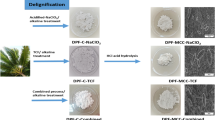Abstract
Different qualities of CMC were prepared from an agricultural residue (date palm rachis) and a marine waste (Posidonia oceanica). These starting lignocellulosic materials were used as such and after chemical pulping and bleaching. The carboxymethylation reaction was carried out in presence of NaOH (40%) and monochloroacetic acid (ClCH2COOH, MAC), in n-butanol as the reaction solvent. The substitution degrees (DS) of the obtained CMCs varied from 0.67 to 1.62 and between 0.98 and 1.86, for P. oceanica and date palm rachis, respectively. The CP-MAS 13C-NMR spectra of the prepared polyelectrolytes displayed the presence of the main peaks associated with cellulose macromolecules (C1–C6) and that corresponding to carboxyl functions at around 175 ppm. Unfortunately, the peak attributed to methylene groups neighbouring carboxyl moieties are overlapped by C2 and C3, which renders them hardly detectable. Nevertheless, it is worth noting that the CP-MAS 13C-NMR spectra revealed the presence of different signals originating from residual impurities (ca. 27 ppm), such as traces of lignin macromolecules (110–150 ppm) and methyl groups attributed to hemicelluloses. Work is in progress to establish a more efficient purification procedure, in order to have more accurate values of DS.









Similar content being viewed by others
References
Aguir C, M’henni MF (2006) J Appl Polym Sci 98:1808–1816
Barai BK, Singhal RS, Kulkarni PR (1997) Carbohydr Polym 32:229–231
Heinze T, Pfeiffer K (1999) Angew Makromol Chim 266:37–45
Mario P, Adinugraha DW, Haryadi D (2005) Carbohydr Polym 62:164–169
Togrul H, Arslan N (2003) Carbohydr Polym 54:73–82
Heinze T, Liebert T, Koschella A (2006) Esterification of polysaccharides. Springer, Berlin, p 232 (ISBN 3-540-32103-9)
Schilling CH, Tomasik P, Karpovich DS, Hart B, Shepardson S, Garcha J, Boettcher PT (2004) J Polym Environ 12:257–264
Wakelyn PJ, Bertoniere NR, French AD, Thibodeaux DP, Triplett BA, Rousselle MA, Goynes WR Jr, Edwards JV, Hunter L, McAlister DD, Gamble GR (2007) Cotton fibre chemistry and technology. CRC Press, Boca Raton (ISBN 1420045873)
Gullichsen J, Paulapuro H (1999) J Tappi 10:810
Barba C, Rinaudo M, Farriol X (2002) Cellulose 9:327–335
Panter G, Kužnik A, Jerala R (2009) Curr Opin Mol Ther 11:133–145
Antunes A, Amaral E, Belgacem MN (2000) Ind Crops Prod 12:85–91
Dutt D, Upadhyaya JS, Tyagi CH, Kumar A, Lal M (2008) Ind Crops Prod 28:128–136
Chia CH, Zakaria S, Nguyen KL, Abdullah M (2008) Ind Crops Prod 28:333–339
Hedjazi S, Kordsachia O, Patt R, Latibari AJ, Tschirner U (2008) Ind Crops Prod 62:142–148
Gezguez I, Dridi-Dhaouadi S, Mhenni F (2009) Ind Crops Prod 29:197–204
Khristova K, Kordsachia O, Khider T (2005) Bioresour Technol 96:79–85
Mahumd MU (1987) Acta Polym 38:172–176
Bandrup J, Immergut EH (1989) Polymer handbook, 3rd edn, Section VII. Wiley, New York
Tapio S, Daniel V, Erkki PE (1994) Ind Eng Chem Res 33:1454–1459
Wilson DeK (1960) Sven Papperstidn 63:714–715
Khiari R, Mhenni MF, Belgacem MN, Mauret E (2010) Bioresour Technol 101:775–780
Hagege R (1998) Technique de l’ingénieurs, plastiques et composites, Edition TI, Paris, (A3980)
Lewin M, Eli MP (1998) Handbook of fibers chemistry, 2nd edn. Wiley Interscience, New York, p 544
Pulkkinen I, Fiskari J, Alopaeus V (2009) J Appl Sci 9:3991–3998
Bootten TJ, Harris PJ, Melton LD, Newman RH (2009) Biomacromolecules 10:2961–2967
Wise LE, Murphy M, D’Addieco AA (1946) Pap Trade J 122:35–43
Acknowledgments
The authors would express their sincere thanks to “IFC”, Institut de Coopération Francaise de l’ambassade de France en Tunisie and the Région Rhône Alpes (Mira program) for their financial supports.
Author information
Authors and Affiliations
Corresponding author
Rights and permissions
About this article
Cite this article
Khiari, R., Mhenni, M.F., Belgacem, M.N. et al. Valorisation of Vegetal Wastes as a Source of Cellulose and Cellulose Derivatives. J Polym Environ 19, 80–89 (2011). https://doi.org/10.1007/s10924-010-0207-y
Published:
Issue Date:
DOI: https://doi.org/10.1007/s10924-010-0207-y




